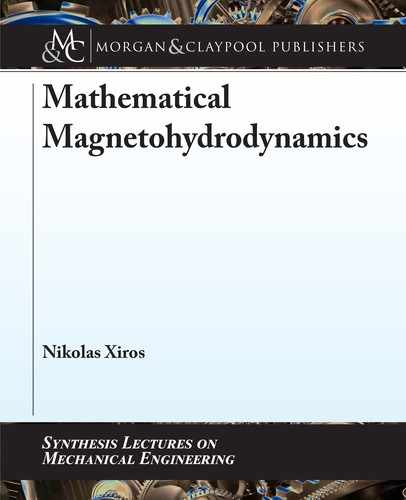
6.2. PRESHEATH 59
which can now be integrated with the result
1
2
dˆ.x/
dx
2
D
en
0
"
0
"
kT
e
exp
eˆ.x/
kT
e
kT
e
C m
i
2
i0
1
2eˆ.x/
m
i
2
i0
1=2
m
i
2
i0
#
: (6.8)
e right-hand side of this equation must not be negative. Sufficiently close to the sheath bound-
ary at x D 0; ˆ.x/ is small. Correspondingly, the exponential and square root functions are ex-
panded to second order, which yields for the expression in brackets
kT
e
eˆ
kT
e
C
1
2
eˆ
kT
e
2
!
m
i
2
i0
eˆ
m
i
2
i0
C
1
2
eˆ
m
i
2
i0
2
!
0 (6.9)
or
.eˆ/
2
kT
e
.eˆ/
2
m
i
2
i0
(6.10)
and finally
i0
B
D
s
kt
e
m
i
: (6.11)
us, the conservation laws and electrostatics can only be fulfilled if the ions enter the
sheath with a velocity which is equal or larger than the “Bohm” or “ion sound” velocity
B
. Equa-
tion (6.11) is also called the Bohm criterion. In a low-pressure pressure plasma with kT
i
<< kT
e
,
this velocity is much larger than the ion thermal velocity. More rigorous calculations show even
that Eq. (6.11) holds even marginally, i.e.,
i0
D
B
: (6.12)
e exact solution of the sheath potential equation (6.5) can only be obtained numerically.
From this, the thickness of the sheath is obtained as
x
s
D .2 : : : 5/
D
: (6.13)
6.2 PRESHEATH
e existence of the Bohm velocity requires that the ions are accelerated on their way from the
bulk plasma to the sheath. From this, a presheath (see Fig. 6.1) must exist in which the potential
of the plasma drops to provide the ion acceleration. Above, we have defined the sheath boundary
in such a way that quasineutrality extends to there, i.e., holds across the presheath. en, from
n
i
.x/ D n
e
.x/
1
n
i
.x/
d n
i
.x/
dx
D
1
n
e
.x/
d n
e
.x/
dx
: (6.14)
..................Content has been hidden....................
You can't read the all page of ebook, please click here login for view all page.
